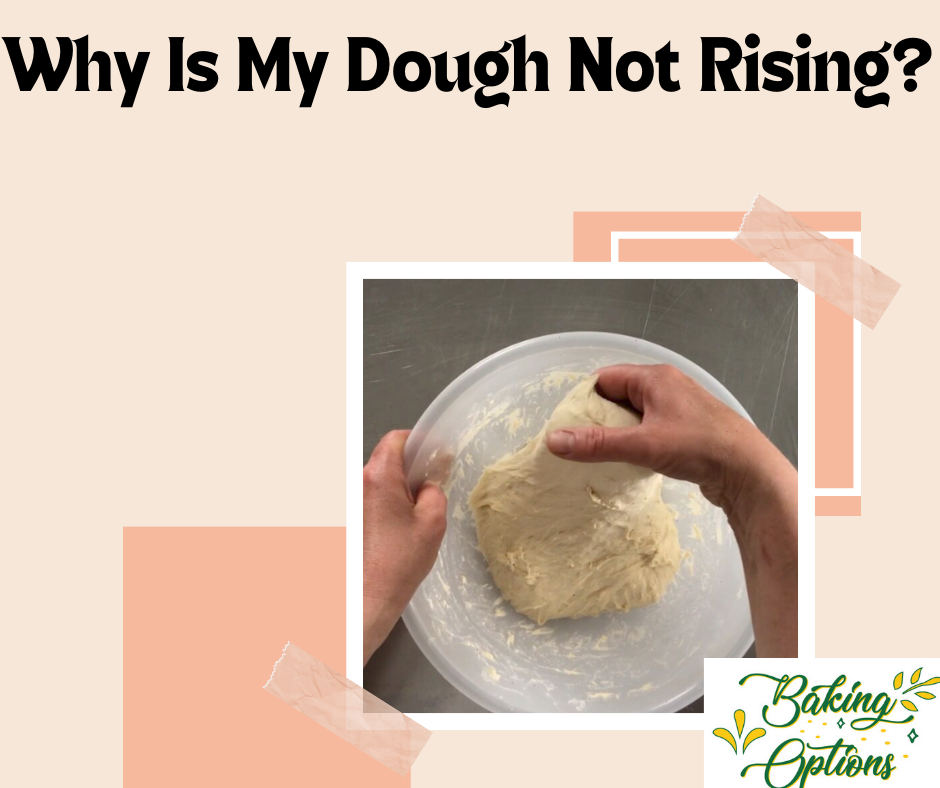Because fermentation gives your bread its polished texture and flavor, dough development is an essential step in any baking process.
I enjoy baking, hence I’m a baker. Even though I’ve been baking for a long time, I don’t particularly enjoy the memories of my first attempts at baking bread, donuts, or cinnamon rolls since I was disappointed when my dough didn’t rise.
So, Why is my dough not rising? I asked the same question earlier, but I now know the answer. I’m not afraid of dough at all now that I know what causes it to rise and what doesn’t!
You are not alone if you have ever wondered why your dough did not rise. Scroll down to find out more!
Contents
Why Is My Bread Dough Not Rising?

Creating bread by hand is one of the most fulfilling experiences ever. Compared to store-bought loaves, homemade bread has a better texture and flavor, and because it requires more effort to make, the flavor is enhanced.
However, if the bread dough does not rise properly, all of your hard work could be in vain. There are numerous reasons why the bread dough could not rise correctly. Let’s talk about them.
Lavain Is Not Active
It’s possible that your unripe starter is the reason your sourdough isn’t rising.
More than anyone else, I know the thrill of raising your first sourdough starter. I made a big mistake back then, wanting to start baking as soon as I saw the air bubbles appear!
It is necessary to feed the starter every day for approximately three to four weeks to bring it ready, even though it may still function under additional yeast.
Furthermore, the time of the feedings should also be accurately determined. Inadequate beginning maintenance allows germs and incorrect enzymes to multiply in between feedings. Meanwhile, feeding too early prevents beneficial yeasts from growing—before the peaks.
Old Yeast
Unfortunately, occasionally the yeast in a package you purchase from the grocery store may already be too weak or outdated to produce a good rise. After testing numerous brands, Saf-Instant Yeast is by far the most dependable!
Since I started using Saf Instant Yeast, I’ve never experienced problems with my yeast rising. I prolong its shelf life by storing it in the refrigerator after opening.
Using fresh yeast that you’ve either recently purchased or refrigerated is always preferable. Yeast can remain viable in your pantry for four to six months, so if you don’t bake frequently, you might have some expired yeast lying around.
That’s why, before starting any recipe, you should always test your yeast and make sure it’s active.
Yeast and Salt Came into Touch
Yeast is killed by salt. Therefore, the rising power of the yeast will be impacted if your salt came into direct contact with the yeast during the ingredient measurement process. This is particularly valid if it came into contact with it for an extended period of time—like in a bread maker.
Make sure to add the yeast or salt to the bread machine first, followed by the flour and then the other ingredient, if you’re using one. This will guarantee that they don’t come into contact with each other before the dough-mixing machine begins.
The Water Is Too Hot
Activating the yeast with too-hot water is another typical cause of the dough not rising. As a living creature belonging to the kingdom of fungi, yeast has a certain temperature range in which it can flourish.
It’s a good idea to reheat the water slightly while making the yeast mixture because lukewarm water causes yeast to activate more quickly. But if you use water that is warmer than 45 C (113 F), the yeast will perish.
Before adding the dry yeast to the water, take a temperature reading. Another way to test the water is to dunk your finger into it. If you are unable to comfortably submerge your finger in the water, the water is too hot.
Before adding the dry yeast to the water, let it cool a bit. If you use too hot water, the yeast will die, but it will take longer to activate in colder water.
Excessive Dough Fat
Despite what many people think, adding fats to dough starter is not the best idea ever—it weakens the gluten links and reduces their ability to trap air.
Even in those rare occasions when the dough rises, its dense texture is guaranteed to make no one happy.
What then should you do if you still want to incorporate lipids without wetting the sourdough? Then, I would suggest adding them halfway through the initial rise of the cake. By then, the gluten structures have had enough time to solidify and become suitable for the introduction of more fat.
Warm Place
The majority of recipes for risen dough require the dough to rise in the refrigerator or on the counter. This is referred to as a gradual rise when the dough is refrigerated, and usually takes place overnight. The dough will usually double in size during the hour-long proofing period while it is rising on the counter.
Make sure that the dough is proving on the counter in a warm area, away from drafts or a chilly area. Yeast likes warm, humid environments. Turning off the temperature in my oven makes it a comfortable place for me.
Because my house is naturally a little bit warmer in the summer, I also find that my dough rises more quickly during this season, taking considerably longer throughout the winter.
Thus, designate a warm area in your house as your designated location for dough rising going forward. It’s okay if your dough takes longer than two hours to rise if your kitchen is cooler! Just have patience and give it a little time.
Too Much Salt and Sugar
The yeast will be slowed down and may even die if you add too much salt. When adding salty items like bacon and Marmite, use caution and slightly reduce the amount of salt you use.
Because yeast works more slowly when it is depleted of water, a dough with a high sugar content will rise more slowly. You will need to add a little more yeast to compensate if your recipe calls for more than 10% sugar to flour weight or be ready to wait longer for the dough to rise.
If you produce a lot of sweet dough, you can purchase osmotolerant yeast, which is designed specifically to handle the added sugar.
Room Temperature Is Too Cold
For yeast to function properly, the temperature must be warm. If the temperature is too low, the bread dough may not rise at all or may rise too slowly. During the winter, when the room temperature drops below 15 C (59 F), this issue may arise more frequently.
Cover the bread dough tightly and bake it at a very low temperature to avoid this issue. The yeast in the bread dough will be killed if the heat is applied too high. To make sure it’s not too chilly, you can also use bread dough rising containers.
How to Fix Dough That Won’t Rise?

The issue that is keeping the dough from rising will determine how you should solve it. The act of kneading bread contributes to the rise of the bread by increasing the gluten content of the dough.
In the event that you notice that the bread is not rising correctly, you can knead it further. Nevertheless, if the yeast is dead, kneading won’t help. In this scenario, you will need to make a fresh, high-quality yeast mixture and use it, along with some flour, to knead the bread dough.
Your bread dough may not be rising for other reasons, such as temperature or humidity. If so, place the bread dough in a warm, dark place, like the oven, and make sure it is well covered.
Sometimes, the bread dough just needs a little extra time to rise. Thus, exercise patience and check to see if the bread dough has risen any higher after 30 to 60 minutes.
Wrap Up
Generally speaking, if the bread is not rising properly, the yeast is either old, dead, or inactive. The last thing we want to happen to our bread is a non-rising dough, but don’t worry. In the worst-case situation, it can still be used to make delectable snacks or sweets!

